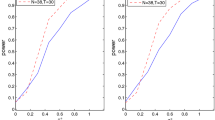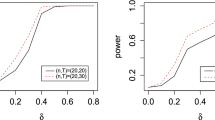Abstract
This paper describes a method for estimation and inference with a nonparametric varying coefficients panel data model that allows for cross-sectional dependence and heteroscedasticity, wherein the time series length T is larger than the cross-sectional size N. We first eliminate fixed effects by taking the cross-sectional average, and then use a local linear approach to obtain the initial estimator of the unknown coefficient functions. However, the initial estimator ignores the cross-sectional dependence and heteroscedasticity, which will lead to a loss of efficiency. Thus, we propose a weighted local linear method to obtain a more efficient estimator. In the theoretical part of the paper, we derive the asymptotic theory of the resulting estimator. Simulation results and a real data analysis are provided to illustrate the finite sample performance of the proposed method.







Similar content being viewed by others
References
Ahn SC, Lee YH, Schmidt P (2001) GMM estimation of linear panel data models with time-varying individual effects. J Econom 101:219–255
Bai J (2003) Inferential theory for factor models of large dimensions. Econometrica 71:135–171
Bai J (2009) Panel data models with interactive fixed effects. Econometrica 77:1229–1279
Cai Z, Li Q (2008) Nonparametric estimation of varying coefficient dynamic panel data models. Econom Theory 24:1321–1342
Cai Z, Fan J, Yao Q (2000) Functional-coefficient regression models for nonlinear time series. J Am Stat Assoc 95:941–956
Elhorst JP (2003) Specification and estimation of spatial panel data models. Int Reg Sci Rev 26:244–268
Fan JCC, Gijbels R (1996) Local polynomial modelling and its applications, vol 66. Chapman & Hall, London
Fan J, Zhang C, Zhang J (2001) Generalized likelihood ratio statistics and wilks phenomenon. Ann Stat 29:153–193
Feng G, Gao J, Peng B, Zhang X (2017) A varying-coefficient panel data model with fixed effects: theory and an application to US commercial banks. J Econom 196:68–82
Fotheringham AS, Brunsdon C, Charlton M (2002) Geographically weighted regression: the analysis of spatially varying relationships, vol 13. Wiley, Berlin
Hastie T, Tibshirani R (1993) Varying-coefficient models. J R Stat Soc 55:757–796
Henderson DJ, Carroll RJ, Li Q (2008) Nonparametric estimation and testing of fixed effects panel data models. J Econom 144:257–275
Huang X (2013) Nonparametric estimation in large panels with cross sectional dependence. Econom Rev 32:754–777
Lee J, Robinson PM (2015) Panel nonparametric regression with fixed effects. J Econom 188:346–362
Li D, Jia C, Gao J (2011) Non-parametric time-varying coefficient panel data models with fixed effects. Econom J 14:387–408
Lin Z, Li Q, Sun Y (2014) A consistent nonparametric test of parametric regression functional form in fixed effects panel data models. J Econom 178:167–179
Pei Y, Huang T, You J (2018) Nonparametric fixed effects model for panel data with locally stationary regressors. J Econom 202:286–305
Pesaran MH (2006) Estimation and inference in large heterogeneous panels with a multifactor error structure. Econometrica 74:967–1012
Robinson PM (1983) Nonparametric estimators for time series. J Time Ser Anal 4:185–207
Robinson PM (2012) Nonparametric trending regression with cross-sectional dependence. J Econom 169:4–14
Zellner A (1962) An efficient method of estimating seemingly unrelated regressions and tests for aggregation bias. J Am Stat Assoc 57:348–368
Acknowledgements
The authors would like to thank the editor, associate editor and two anonymous referees for many helpful comments and suggestions, which greatly improved the paper. Liu’s research was supported by Shanghai University of Finance and Economics Innovation Fund for Graduate Student (CXJJ-2017-425). Dr. Pei’s research was partially supported by The Fundamental Research Funds of Shandong University (No. 2018GN050), the Academic Prosperity Program provided by School of Economics, Shandong University and the Taishan Scholar Program of Shandong Province. Dr Xu’s research is financially supported by Projects of National Social Science Fund of China (No. 19BTJ032).
Author information
Authors and Affiliations
Corresponding author
Ethics declarations
Conflict of interest
On behalf of all authors, the corresponding author states that there is no conflict of interest.
Additional information
Publisher's Note
Springer Nature remains neutral with regard to jurisdictional claims in published maps and institutional affiliations.
Appendix
Appendix
Note that Theorems 1–2 follow immediately from Cai et al. (2000) and Theorem 6 follows immediately from Fan et al. (2001), so we omit the proof details here.
Proof of Theorem 3
\({\widetilde{w}}_{ij}(z)-w_{ij}(z)\) can be written as
with
We can regard \(R_{ij}^{(1)}\) as the estimation error of the usual local constant estimator of the conditional expectation \(E(U_{it}U_{jt}|z_t=z)\). Under the assumptions given in this paper and the results of the local constant estimator, it can be shown that \(|R_{ij}^{(1)}|=O_p(a^2+\frac{1}{\sqrt{Ta}})\) under Assumptions 1–4. Next, we prove the bound of \(R_{ij}^{(2)}\). Denote \(d_{it}: =\varvec{X}_{it}^{\tau }[\varvec{m}(z_t)-\widehat{\varvec{m}}(z_t)]\), \(e_i: =\frac{1}{T}\sum \nolimits _{s=1 }^T\varvec{X}_{is}^{\tau }[\varvec{m}(z_s)-\widehat{\varvec{m}}(z_s)]\) and \(f_i: =\frac{1}{T}\sum \nolimits _{s=1 }^TU_{is}\). From (22), \({\widehat{U}}_{it} \) can be expressed as follows
where using this equality, we can decompose
We let \(K^{\star }_t:=K^{\star }_a(z_t-z)\) for brevity. Thus, \(R_{ij}^{(2)}\) can be expressed as
where \({\widehat{f}}(z)\) is a nonparametric kernel estimator of f(z):
Under the assumptions stated in this paper, Lee and Robinson (2015) proved that \({\widehat{f}}(z)\) is consistent. Therefore,
Now, we need only find the upper bound of
Firstly, we prove the bound of \(\frac{1}{Ta}\sum \nolimits _{s=1}^TK^{\star }_sI\).
- 1.
As the \(U_{it}\) are weakly dependent across time and Assumption 3 implies that \(w_{ii},w_{ij}\) are bounded, we have
$$\begin{aligned} f_i=O_p\left( \frac{1}{\sqrt{T}}\right) . \end{aligned}$$(33)Additionally, the weak dependence among \((\varvec{X}_{it},z_t)\) and Theorem 1 lead to the following result:
$$\begin{aligned} e_i=O_p\left( \frac{h^2}{T}+\frac{1}{T\sqrt{h}}\right) . \end{aligned}$$(34) - 2.
Because \(\frac{1}{Ta}\sum \nolimits _{s=1}^TK^{\star }_sU_{is}\) is the consistent estimator of \(E(U_{it}|z_t=z)=0\) with zero bias, we have that
$$\begin{aligned} \frac{1}{Ta}\sum \limits _{s=1}^TK^{\star }_sU_{is}=O_p \left( \frac{1}{\sqrt{Ta}}\right) . \end{aligned}$$(35)
Secondly, we analyze the bound of \(\frac{1}{Ta}\sum \nolimits _{s=1}^TK^{\star }_sII\).
- 1.
For the first term \(\frac{1}{Ta}\sum \nolimits _{s=1}^TK^{\star }_sd_{is}\), we get
$$\begin{aligned} E\left\{ \frac{1}{Ta}\sum \limits _{s=1}^TK^{\star }_sd_{is}\right\} =E\left\{ E\left\{ \frac{1}{a}K^{\star }_sd_{is}|z_s\right\} \right\} =O(h^2) \end{aligned}$$and
$$\begin{aligned} E\left\{ \frac{1}{Ta}\sum \limits _{s=1}^TK^{\star }_sd_{is}\right\} ^2 =\frac{1}{Ta^2}E\left\{ E\left\{ K^{\star 2}_sd_{is}^2|z_s\right\} \right\} =O\left( \frac{1}{Ta}\left( h^4+\frac{1}{Th}\right) \right) . \end{aligned}$$Therefore, the upper bound of \(\frac{1}{Ta}\sum \nolimits _{s=1}^TK^{\star }_sd_{is}\) is
$$\begin{aligned} \frac{1}{Ta}\sum \limits _{s=1}^TK^{\star }_sd_{is}=O_p \left( h^2+\frac{1}{\sqrt{T^2ha}}\right) . \end{aligned}$$(36) - 2.
Similar to the proof of (36), we have that
$$\begin{aligned} E\left\{ \frac{1}{Ta}\sum \limits _{s=1}^TK^{\star }_sU_{is}d_{is}\right\} =E\left\{ \frac{1}{a}K^{\star }_sU_{is}d_{is}\right\} =E\left\{ E\left\{ \frac{1}{a}K^{\star }_sU_{is}d_{is}|z_s\right\} \right\} =0. \end{aligned}$$and
$$\begin{aligned} E\left\{ \frac{1}{Ta}\sum \limits _{s=1}^TK^{\star }_sU_{is}d_{is}\right\} ^2 =\frac{1}{Ta}E\left\{ E\left\{ \frac{1}{a}K^{\star 2}_sU_{is}^2d_{is}^2|z_s\right\} \right\} =O\left( \frac{1}{Ta}\left( h^4+\frac{1}{Th}\right) \right) . \end{aligned}$$Then, the upper bound of \(\frac{1}{Ta}\sum \nolimits _{s=1}^TK^{\star }_sU_{is}d_{is}\) is
$$\begin{aligned} \frac{1}{Ta}\sum \limits _{s=1}^TK^{\star }_sU_{is}d_{is} =O_p\left( \frac{h^2}{\sqrt{Ta}}+\frac{1}{\sqrt{T^2ha}}\right) . \end{aligned}$$(37) - 3.
Next, we derive the bound of \(\frac{1}{Ta}\sum \nolimits _{s=1}^TK^{\star }_sd_{is}d_{js}\). Similar to the proof of (37), we have that the bound of \(\frac{1}{Ta}\sum \nolimits _{s=1}^TK^{\star }_sd_{is}d_{js}\) is
$$\begin{aligned} \frac{1}{Ta}\sum \limits _{s=1}^TK^{\star }_sd_{is}d_{js}=O_p \left( \frac{1}{Th}+h^4\right) . \end{aligned}$$(38)
Combining (36)–(38), we conclude that
and \(R_{ij}^{(1)}=O_p\Big (a^2+\frac{1}{\sqrt{Ta}}\Big )\). According to Assumption 6, the following equation holds:
Proof of Theorem 4
We only provide the proof for \(\frac{h_j^{\star }}{{\widehat{h}}_j^{\star }}\overset{P}{\rightarrow }1\), as the proof for \(\frac{{\widetilde{h}}_j^{\star }}{\widehat{{\widetilde{h}}}_j^{\star }}\overset{P}{\rightarrow }1\) follows by the same argument.
Let
By the mean value theorem, the second term in (39) is bounded in absolute value by
where \(r_i,i=1,2,3\) are derivatives of the expression of \(\{\frac{\theta _j}{f(z)(\varvec{m}_j''(z))^2}\}^{\frac{1}{5}}\) with respect to \(\theta _j,f,(m_j'')^2\).
\({\widetilde{r}}_1\) lies in
\({\widetilde{r}}_2\) lies in
and \({\widetilde{r}}_3\) lies in
Hence, we deduce the upper bound of (40) as
where the last step follows from Assumption 7. Thus, (39) becomes
Proof of Theorem 5
First, we denote \(\varvec{A}=\varvec{I}_T\otimes \varvec{1}_N^{\tau }\), \(\varvec{Y}= (\varvec{Y}_{.1},\ldots ,\varvec{Y}_{.T})\), \(\varvec{Xz}=(\varvec{Xz}^{\tau }_1,\ldots ,\varvec{Xz}^{\tau }_T)^{\tau }\) with the blocks \(\varvec{Xz}_t =(\varvec{X}_{.t}, \varvec{X}_{.t}(z_t-z))\), \(\varvec{B}\) and \(\widetilde{\varvec{B}}\) are both block diagonal matrices with the blocks \(\varvec{\varSigma }^{-\frac{1}{2}}(\varvec{z}_t)\) and \(\widetilde{\varvec{\varSigma }}^{-\frac{1}{2}}(\varvec{z}_t)\) respectively. Thus, we can express \(\varvec{Y}_{\varvec{\varSigma }}\) and \(\varvec{Y}_{\widetilde{\varvec{\varSigma }}}\) as
which leads to
Next, we decompose \(\widetilde{\varvec{m}}(z)-\widetilde{\varvec{m}}^{\star }(z)\) as follows
The bound for the every part in the last step is
Hence, \(\widetilde{\varvec{m}}(z)-\widetilde{\varvec{m}}^{\star }(z)\) is bounded by
According to the mean value theorem, \(\Vert \varvec{B}-\varvec{{\widetilde{B}}}\Vert \) is bounded by \(|l\Vert |\varvec{B}^{-2}-\varvec{{\widetilde{B}}}^{-2}\Vert \), and l lies in \([-\frac{1}{2}B^3,-\frac{1}{2}\varvec{{\widetilde{B}}}^3]\), so
Thus,
Combined with
we have that
Because \(N(Th)^{-1}=o(N^{-\frac{1}{2}}(Th)^{-\frac{1}{2}})=o((Th)^{-\frac{1}{2}})\), which is implied by \(N^3/(Th)\rightarrow 0\), Assumption 6-(b) implies that \(NR_{T,a,h}=o(\frac{1}{\sqrt{Th}}+h^2)\).
Rights and permissions
About this article
Cite this article
Liu, H., Pei, Y. & Xu, Q. Estimation for varying coefficient panel data model with cross-sectional dependence. Metrika 83, 377–410 (2020). https://doi.org/10.1007/s00184-019-00739-0
Received:
Published:
Issue Date:
DOI: https://doi.org/10.1007/s00184-019-00739-0
Keywords
- Cross-sectional dependence
- Local linear method
- Panel data model
- Three-step generalized kernel approach
- Varying coefficient




